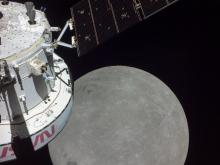Listen to today's episode of StarDate on the web the same day it airs in high-quality streaming audio without any extra ads or announcements. Choose a $8 one-month pass, or listen every day for a year for just $30.
You are here
Moon and Venus
The Moon and Venus team up for an impressive display early this evening. They’re in the west-southwest as night falls. Venus, the “evening star,” is close to the lower left of the Moon. At the same time, the planet Jupiter, the next-brightest object in the night sky, is over in the southeast.
Venus and Jupiter stay hundreds of millions of miles apart. But that probably hasn’t always been so. When the solar system was younger, Jupiter probably moved much closer to the Sun than it is today. And that could have been bad news for Venus.
Jupiter is the biggest planet in the solar system, and more than twice as massive as all the other planets combined. A study about a year ago reported that Jupiter could have used that heft to push around the inner planets, including Venus.
Scientists don’t agree on Venus’s early history. But some say it’s possible that the younger Venus had a lot of liquid water. It’s even possible that the planet could have had life. But Jupiter might have changed Venus’s orbit in a way that caused it to lose much of the water to space. As Jupiter backed away from the Sun, that could have left Venus dry and dead — or at least mostly dead. Microbes could have moved into the clouds — and might still be there today.
New missions to Venus were approved earlier this year. They’ll hunt for evidence that Venus was much wetter in the distant past — perhaps until Jupiter caused it to dry out.
Script by Damond Benningfield






